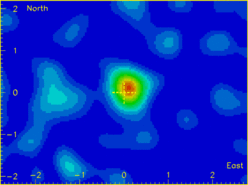ميوون
 ظل الآشعة الكونية للقمر، كما يشاهـَد في الميوونات الثانوية المتولدة من الآشعة الكونية في الغلاف الجوي، وتـُرصد على عمق 700 متر تحت الأرض، في المجس سودان 2 | |
| تركيب | جسيم أولي |
|---|---|
| المجموعة | لپتون |
| الجيل | Second |
| التفاعل | جاذبية، كهرومغناطيسي، ضعيف |
| جسيم مضاد | أنتيميوون (μ+) |
| اُكتـُشـِف | كارل أندرسون (1936) |
| الرمز | μ− |
| الكتلة | 105.65836668(38) MeV/c2 |
| متوسط العمر | 2.197034(21)×10−6 s[1] |
| الكتلة الكهربائية | −1 e |
| شحنة اللون | None |
| سپين | 1⁄2 |
ميوون muon (![]() /ˈmjuːɒn/؛ من الحرف اليوناني ميو (μ) يُستخدم لتمثيله) هو جسيم أولي مماثل للإلكترون، بشحنة كهربائية سالبة وحدوية وسپين بمقدار ½. ومع الإلكترون، التاو، وثلاثة نيوترينوات، فإنه يُصنـَّف على أنه لپتون. وكما هو الحال مع اللپتونات الأخرى، فإن الميوون لا يُعتقد أن له بنى جزئية على الإطلاق (أي أنه لا يُعتقد أنه يتكون من جسيمات أبسط).
/ˈmjuːɒn/؛ من الحرف اليوناني ميو (μ) يُستخدم لتمثيله) هو جسيم أولي مماثل للإلكترون، بشحنة كهربائية سالبة وحدوية وسپين بمقدار ½. ومع الإلكترون، التاو، وثلاثة نيوترينوات، فإنه يُصنـَّف على أنه لپتون. وكما هو الحال مع اللپتونات الأخرى، فإن الميوون لا يُعتقد أن له بنى جزئية على الإطلاق (أي أنه لا يُعتقد أنه يتكون من جسيمات أبسط).
والميوون هو جسيم تحت ذري غير مستقر بمتوسط عمر 2.2 μs. وعمر التحلل هذا الطويل نسبياً (ثاني أطول عمر معروف) هو بسبب being mediated by the weak interaction. The only longer lifetime for an unstable subatomic particle is that for the free neutron, a baryon particle composed of quarks, which also decays via the weak force. All muons decay to three particles (an electron plus two neutrinos of different types), but the daughter particles are believed to originate newly in the decay.
Like all elementary particles, the muon has a corresponding antiparticle of opposite charge but equal mass and spin: the antimuon (also called a positive muon). Muons are denoted by μ− and antimuons by μ+. Muons were previously called mu mesons, but are not classified as mesons by modern particle physicists (انظر التاريخ).
Muons have a mass of 105.7 MeV/c2, which is about 200 times the mass of an electron. Since the muon's interactions are very similar to those of the electron, a muon can be thought of as a much heavier version of the electron. Due to their greater mass, muons are not as sharply accelerated when they encounter electromagnetic fields, and do not emit as much bremsstrahlung (deceleration radiation). This allows muons of a given energy to penetrate far more deeply into matter than electrons, since the deceleration of electrons and muons is primarily due to energy loss by the bremsstrahlung mechanism. As an example, so-called "secondary muons", generated by cosmic rays hitting the atmosphere, can penetrate to the Earth's surface, and even into deep mines.
Because muons have a very large mass and energy compared with the طاقة التحلل of radioactivity, they are never produced by radioactive decay. They are, however, produced in copious amounts in high-energy interactions in normal matter, such as occur during certain particle accelerator experiments with hadrons, and also naturally in cosmic ray interactions with matter. These interactions usually first produce pi mesons, which then most often decay to muons.
As with the case of the other charged leptons, the muon has an associated muon neutrino. Muon neutrinos are denoted by νμ.
. . . . . . . . . . . . . . . . . . . . . . . . . . . . . . . . . . . . . . . . . . . . . . . . . . . . . . . . . . . . . . . . . . . . . . . . . . . . . . . . . . . . . . . . . . . . . . . . . . . . . . . . . . . . . . . . . . . . . . . . . . . . . . . . . . . . . . . . . . . . . . . . . . . . . . . . . . . . . . . . . . . . . . . .
التاريخ
الميوونات اكتشفها كارل أندرسون وسث ندرماير في كالتك عام 1936، أثناء دراستهما الإشعاع الكوني. Anderson had noticed particles that curved differently from electrons and other known particles when passed through a magnetic field. They were negatively charged but curved less sharply than electrons, but more sharply than protons, for particles of the same velocity. It was assumed that the magnitude of their negative electric charge was equal to that of the electron, and so to account for the difference in curvature, it was supposed that their mass was greater than an electron but smaller than a proton. Thus Anderson initially called the new particle a mesotron, adopting the prefix meso- from the Greek word for "mid-". Shortly thereafter, additional particles of intermediate mass were discovered, and the more general term meson was adopted to refer to any such particle. To differentiate between different types of mesons, the mesotron was in 1947 renamed the mu meson (the Greek letter μ (mu) corresponds to m).
It was soon found that the mu meson significantly differed from other mesons in that they did not interact with the nuclear force. Also, the mu meson's decay products included a neutrino and an antineutrino, rather than just one or the other, as was observed with other mesons. Other mesons were eventually understood to be hadrons—that is, particles made of quarks—and thus subject to the nuclear force. In the quark model, a meson is composed of exactly two quarks (a quark and antiquark), unlike baryons, which are composed of three quarks. Mu mesons, however, were found to be fundamental particles (leptons) like electrons, with no quark structure. Thus, mu mesons were not mesons at all (in the new sense and use of the term meson), and so the term mu meson was abandoned, and replaced with the modern term muon.
Another particle (the pion, with which the muon was initially confused) had been predicted by theorist Hideki Yukawa:[2]
"It seems natural to modify the theory of Heisenberg and Fermi in the following way. The transition of a heavy particle from neutron state to proton state is not always accompanied by the emission of light particles. The transition is sometimes taken up by another heavy particle."
The existence of the muon was confirmed in 1937 by J. C. Street and E. C. Stevenson's cloud chamber experiment.[3] The discovery of the mu-meson muon as a simple "heavy electron" seemed so incongruous and surprising at the time, that Nobel laureate I. I. Rabi famously quipped, "Who ordered that?"
في تجربة روسي-هال (1941)، اُستُخدمت الميوونات لملاحظة تمدد الزمن (أو بدلاً من ذلك، انكماش الطول) الذي توقعته النسبية الخاصة، لأول مرة.
مصادر الميوونات
About 10,000 muons reach every square meter of the earth's surface a minute; these charged particles form as by-products of cosmic rays colliding with molecules in the upper atmosphere. Travelling at relativistic speeds, muons can penetrate tens of meters into rocks and other matter before attenuating as a result of absorption or deflection by other atoms.[4]
تحلل الميوون
The dominant muon decay mode (sometimes called the Michel decay after لوي ميشل) is the simplest possible: the muon decays to an electron, an electron-antineutrino, and a muon-neutrino. Antimuons, in mirror fashion, most often decay to the corresponding antiparticles: a positron, an electron-neutrino, and a muon-antineutrino. In formulaic terms, these two decays are:
- .
The mean lifetime of the (positive) muon is 2.197019±0.000021 μs.[5] The equality of the muon and anti-muon lifetimes has been established to better than one part in 104.
عرض تحلل ميوون مستوى الشجرة هو
حيث و هو ثابت تعشيق فرمي.
العزم الشاذ لثنائية الأقطاب المغناطيسية
where the first errors are statistical and the second systematic.
انظر أيضاً
الهامش
- ^ K. Nakamura et al. (Particle Data Group), J. Phys. G 37, 075021 (2010), URL: http://pdg.lbl.gov
- ^ Yukaya Hideka, On the Interaction of Elementary Particles 1, Proceedings of the Physico-Mathematical Society of Japan (3) 17, 48, pp 139-148 (1935). (Read 17 November 1934)
- ^ New Evidence for the Existence of a Particle Intermediate Between the Proton and Electron", Phys. Rev. 52, 1003 (1937).
- ^ Mark Wolverton (September 2007). "Muons for Peace: New Way to Spot Hidden Nukes Gets Ready to Debut". Scientific American. 297 (3): 26–28.
- ^ MuLan Collaboration; Chitwood; Banks; Barnes; Battu; Carey; Cheekatmalla; Clayton; Crnkovic (2007). "Improved Measurement of the Positive Muon Lifetime and Determination of the Fermi Constant". Phys.Rev.Lett.99:032001,2007. 99 (3). arXiv:0704.1981. Bibcode:2007PhRvL..99c2001C. doi:10.1103/PhysRevLett.99.032001.
- S.H. Neddermeyer, C.D. Anderson (1937). "Note on the Nature of Cosmic-Ray Particles". Physical Review. 51 (10): 884–886. Bibcode:1937PhRv...51..884N. doi:10.1103/PhysRev.51.884.
- J.C. Street, E.C. Stevenson (1937). "New Evidence for the Existence of a Particle of Mass Intermediate Between the Proton and Electron". Physical Review. 52 (9): 1003–1004. Bibcode:1937PhRv...52.1003S. doi:10.1103/PhysRev.52.1003.
- G. Feinberg, S. Weinberg (1961). "Law of Conservation of Muons". Physical Review Letters. 6 (7): 381–383. Bibcode:1961PhRvL...6..381F. doi:10.1103/PhysRevLett.6.381.
- Serway & Faughn (1995). College Physics (4th ed.). Saunders. p. 841.
- M. Knecht (2003). "The Anomalous Magnetic Moments of the Electron and the Muon". In B. Duplantier, V. Rivasseau (ed.). [[Poincaré Seminar]] 2002: Vacuum Energy – Renormalization. Progress in Mathematical Physics. Vol. 30. Birkhäuser Verlag. p. 265. ISBN 3-7643-0579-7.
{{cite book}}: URL–wikilink conflict (help) - E. Derman (2004). My Life As A Quant. Wiley. pp. 58–62.






